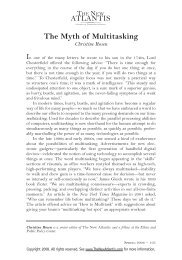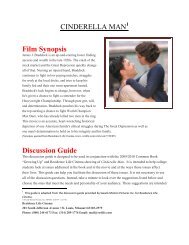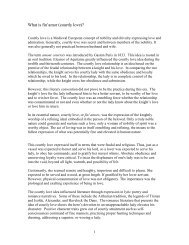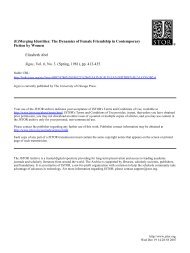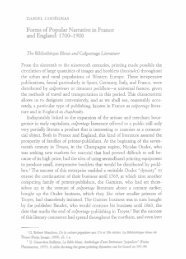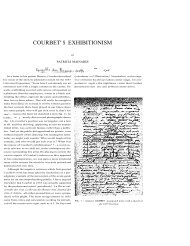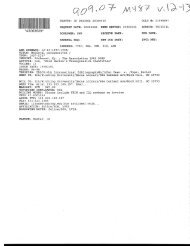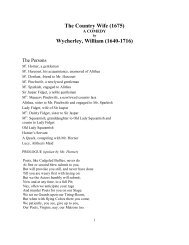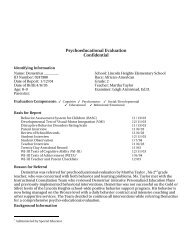CARRIE MAE WEEMS - People Search Directory
CARRIE MAE WEEMS - People Search Directory
CARRIE MAE WEEMS - People Search Directory
Create successful ePaper yourself
Turn your PDF publications into a flip-book with our unique Google optimized e-Paper software.
"She felt like she was walking through<br />
a storm, like she was in a lonesome<br />
graveyard, like she had many rivers to<br />
cross, like making a way out of no<br />
way was her fate in life, like nobody<br />
knew the trouble she'd seen, like a<br />
change gotta come,..."<br />
wood of the tabletop emphasize its planar<br />
recession and underline the objects<br />
placed upon it. These personal objects<br />
have the studied casualness of a 17th-century<br />
Dutch still life-the cigarettes, ashtrays,<br />
drinking glasses, playing cards<br />
become attributes of modern emotional<br />
life. The text for Untitled reveals a finely<br />
cocked ear for the vernacular. It combines<br />
a free-flowing association of folk sayings<br />
and lines from oft-heard songs, as familiar<br />
as the furnishings of one's home, to create<br />
a parable of contemporary life.<br />
The format of Untitled is related to a<br />
tradition of narrative photographic fictions<br />
and to the use of serial photography by<br />
conceptual artists. It is also clearly related<br />
to film, as if we were given a script and<br />
storyboards. Yet the intricate choreography<br />
of the figures, down to the subtlest<br />
detail of a glance or gesture, would be<br />
impossible on film-it would be more<br />
likely in dance or in history painting from<br />
an earlier period. The work is, in part, a<br />
conscious response to feminist film criticism,<br />
particularly Laura Mulvey's analysis<br />
of the problems inherent in female representation."<br />
The photographer is the model<br />
for the main protagonist of Untitled. TIlis<br />
knowledge allows the viewer, in identifying<br />
with the photographer, to identify<br />
with her subject as well. The text always<br />
brings the viewer back to the narrative.<br />
Written in the third person, it is firmly<br />
anchored in the female voice, even when<br />
it opens up to allow her lover his say.<br />
Weems has discussed the fact that<br />
Mulvey's analysis of female representation<br />
in film entirely elides the issue of women<br />
of color. J; With her Untitled series, Weems<br />
challenges this omission, and looks back.<br />
Her protagonist not only functions independently<br />
of the white women who are<br />
her friends (upsetting the usual role<br />
assigned black women in white films), but<br />
several times within the sequence she<br />
stares directly at the viewer. Weems takes<br />
control of her own space, refusing to be<br />
the compliant object of "the gaze."<br />
"... I say now, [/the white folks fight for<br />
thyself, and the blackfolk fight for thyself,<br />
we gonna crumble apart... There's white<br />
that su/fer, there's Indian people that suffer,<br />
there's Mexican American people that<br />
suffer, there's Chinese people tbat suffer,<br />
and I'm perfectly willing to make this<br />
country what it have to be. We gonna<br />
have to fight these battles TOGETHER. "<br />
Fannie Lou Hamer 14<br />
In 1990 Weems produced her first<br />
color work, when she was invited by<br />
Polaroid Corporation to use their 20 x 24<br />
camera. One of three such experimental<br />
cameras, it produces large, unique images<br />
of highly saturated color. At the time<br />
Weems was accustomed to black and<br />
white photography's abstraction of chromatic<br />
range, and equally concerned with<br />
the abstract nature of racial categories.<br />
The subject of her Polaroid series is the<br />
universal one of social eqUity. Perhaps it<br />
should not surprise us that the images she<br />
produced with the Polaroid camera, using<br />
a series of filters, were monochrome-a<br />
warm sepia, more or less the color of her<br />
own skin (plates 38-43)<br />
The Polaroid images became part of<br />
an installation titled And 22 Million Very<br />
Tired and Very Angry <strong>People</strong>. The installation<br />
consisted of thirteen still [ifes, each of<br />
a single subject, plus single images of an<br />
armed man and a veiled woman. All fifteen<br />
photographs were captioned and<br />
arranged around the periphery of the<br />
space. Above the photographs Weems<br />
hung banners of text, evoking the voices<br />
of writers and theorists she admires:<br />
Fannie Lou Hamer, Antonio Gramsci,<br />
Ntozake Shange, Gabriel Garcia Marqut'z,<br />
Anton Chekhov, Malcolm X and others.<br />
The photographs with suspended texts<br />
take the form of a primer, instructing the<br />
viewer about the role of the individual in<br />
the cause of political change.<br />
And 22 Million ... is a call to social<br />
action by an artist grounded in theory<br />
who wants to go beyond abstract ideals<br />
Weems has referred to the installation as<br />
her "kitchen piece," an attempt to get certain<br />
issues on the table. The objects in her<br />
still Iifes have a particularly homey feel: a<br />
rolling pin (captioned By Any Means<br />
Necessary), a bedside alarm clock (A<br />
Precise Moment in Time), a manual typewriter,<br />
hardly the latest model (An<br />
Informational System). The installation<br />
addresses social and political awareness,<br />
but offers no single or clear reading. Are<br />
15




